SafeHome.org may receive compensation from some providers listed on this page. Learn More
We may receive compensation from some providers listed on this page. Learn More
SafeHome.org may receive compensation from some providers listed on this page. Learn More
We may receive compensation from some providers listed on this page. Learn More
Affordable plug-and-play security cameras are tops in video quality, and perform well despite occasional tech hiccups.

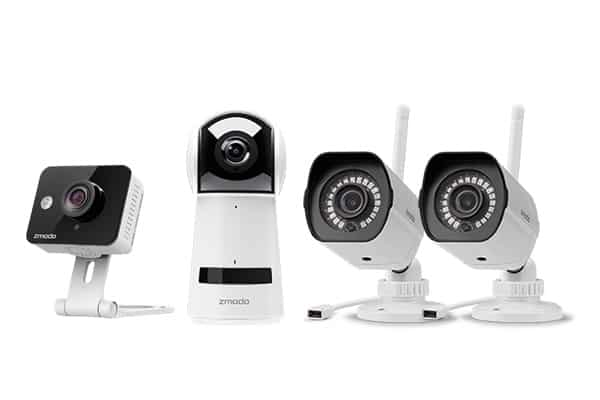
Editor’s Note: Zmodo cameras are a great choice, but we still recommend getting the new Nest cameras that ADT sells. Check out our ADT review to learn more.
Before we start, we have a riddle for you. What’s small, cute, and takes great pictures?
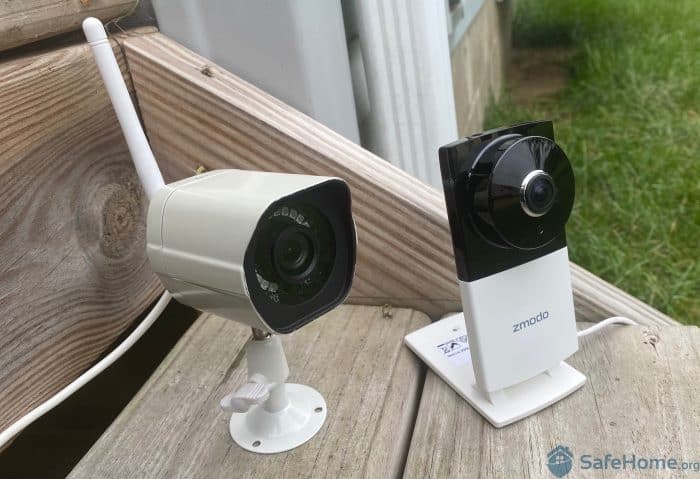
Zmodo cameras on display
It’s Zmodo! This Chinese company is an electronics powerhouse that boasts some rock-solid security equipment. While they’re not going to blow you away in terms of features, they are great when it comes to core functionality and affordability.
While Zmodo offers a pretty extensive lineup of cameras — maybe rivaled only by Ezviz or Lorex — we’re going to be talking about two specific cameras today: the 1080p Indoor/Outdoor Wi-Fi cam, and the Sight 180 C, another low-profile camera that’s just as happy outdoors as in.
Pro Tip: If you’re looking for indoor security, check out Zmodo’s new Mini Pro. It offers AI-powered alerts, a 130 degree field of vision, and a compact design that’ll blend right in to your existing decor. And at $39.99, it’s not going to break the bank, either.
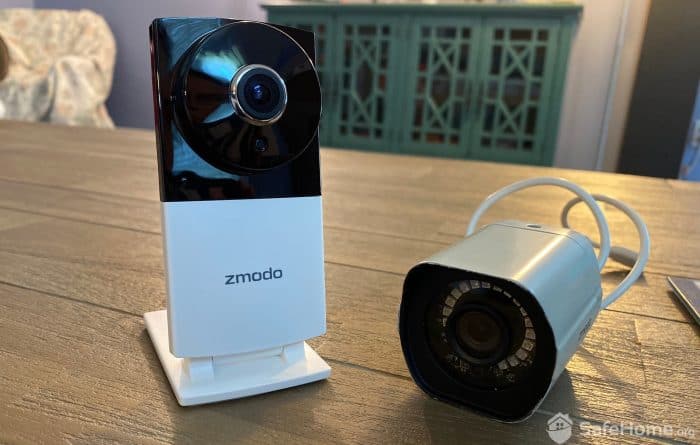
Zmodo security cameras
We’re going to really dig into these cameras’ features and capabilities, but first, let’s take a quick inventory of the pros and cons we discovered in our tests.
Check out more recommendations from the SafeHome team:



One of the first benefits of Zmodo cameras is immediately apparent when you open the box. There’s not a lot inside, a good indication of an easy set up process. In the 1080p Indoor/Outdoor Wi-Fi Cam box, we found the camera itself, a power cable, and an adapter along with some screws you’ll need. The same goes for the Sight 180 C package.
Immediately, that tells us that these are simple plug-and-play cameras, and from our past experience, we know these types of cameras can be set up in under 10 minutes. Of course, that is not a rarity these days. Even the more advanced battery-powered cameras from Blink I recently tested took only 10 minutes to install.
FYI: If you’re looking for a camera as affordable as Zmodo, but with a more stylish look, consider YI, a relative newcomer to the market that makes a neat little $20 camera. We covered that and more in our hands-on YI camera review, if you’re interested.
For the bullet-type Indoor/Outdoor Wi-Fi Cam, all we had to do was find a good spot, line up the camera so it’s fixed in exactly the position we wanted it, and – a few screws and a little elbow grease later – we were up and running.
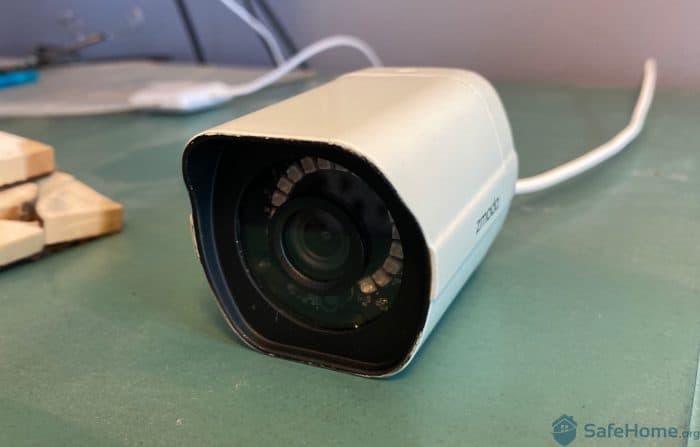
Zmodo 1080p
Securing the camera onto its wall mount took the longest time at around five minutes, but this part was important. While we were installing this outdoor camera, we noticed that it’s pretty top heavy, so we made sure to secure the unit completely so it doesn’t fall out of alignment or worse, fall out completely.
We double- and triple-checked to make sure our camera was secure before we went back inside, just in case. And we recommend that you do the same.
Now, a little piece of advice, while this is called an indoor/outdoor camera, its bulky design is more fitting for outdoor use. It doesn’t exactly fit-in indoors. If you’re looking for something to use indoors, the Sight 180 C is more appropriate.
Did You Know? DIY camera installation is usually easy, but keep in mind that security cameras are vulnerable to theft, especially when they’re outside or otherwise prominently displayed. Be sure to secure your cameras with any anti-theft or security hardware included in the package.
Once the other camera was set up, we turned our attention to our next piece of equipment – the Sight 180 C. Funny enough, it really reminded us of a bare-bones Lorex Doorbell Camera — probably because of the design of the lens and the overall size and shape of the unit itself.
That said, we could immediately tell that this camera was designed to prioritize versatility. The attached support stand is adjustable, and the size and weight make it easy to attach to the wall. It does just as well sitting on your kitchen counter as it would mounted in your living room — all it takes is a few screws here and there.
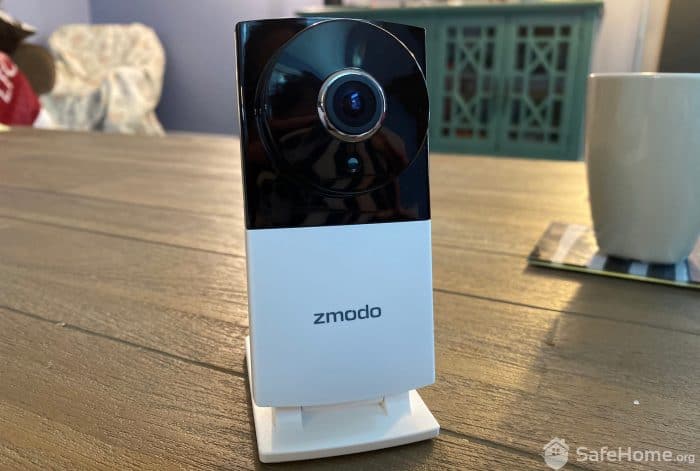
Zmodo Sight 180 C
With both cameras in place, we turned to Zmodo’s app to continue with the setup process.
Ah, the app. We love having one centralized platform to view our cameras, and access all of their features. Keep in mind that setting up security cameras these days almost always requires downloading an app, and this was no different.
From there, we followed the prompts to set up each camera in the app’s dashboard.
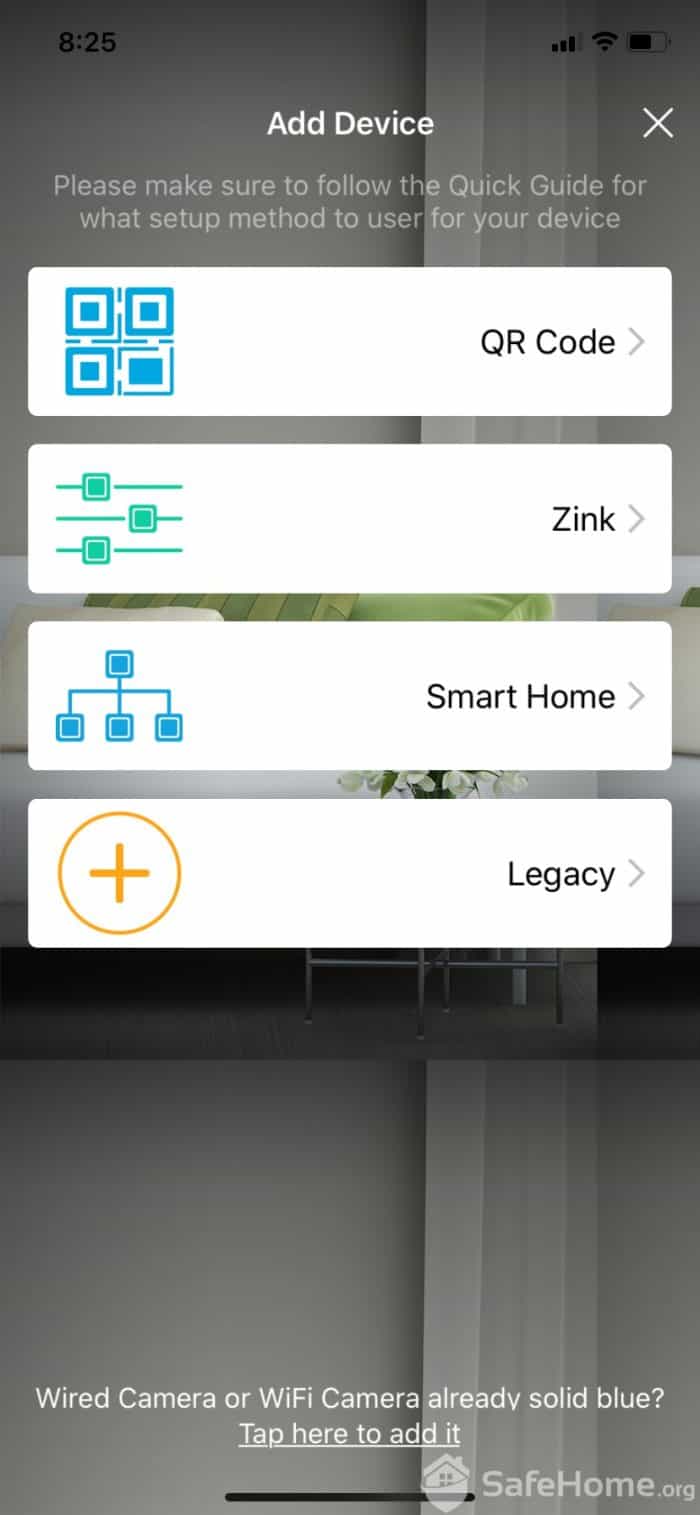
Zmodo app device addition
This is where things got just a little clunky – for a minute.
The app told us that in order to set up our devices, we had to put in our Wi-Fi network login and password. Pretty easy, right?
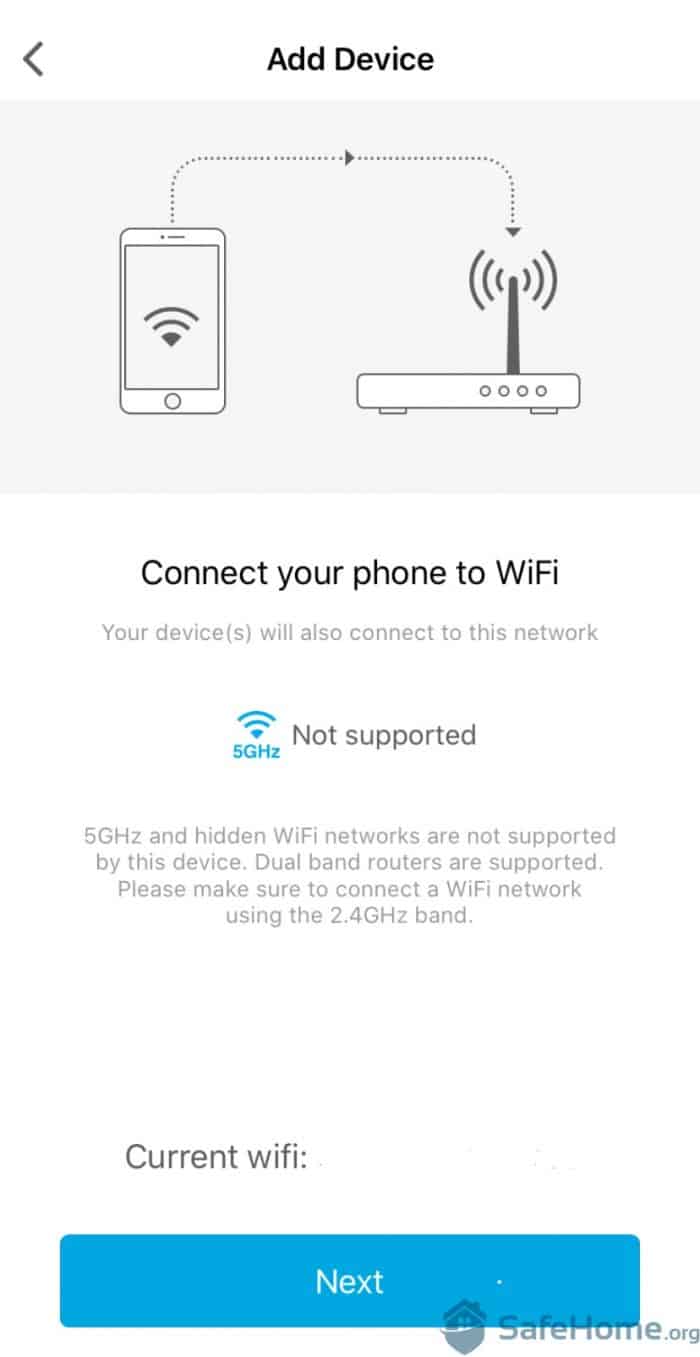
Zmodo app Wi-Fi connection
Except that this process was a little different. When we accidentally put in the wrong Wi-Fi password the first time, the app moved to the next step – scanning the camera’s QR code2 – rather than prompting us to re-insert the password.
We found that the app doesn’t exactly connect the camera to Wi-Fi. Rather, it was just an interface that beams whatever information we input back to the camera, so when we put in the wrong password, it just relayed the information without checking the network. Well, no biggie; once we realized what had happened, we started over, entered the right credentials, and got the camera connected pretty quickly.
That minor hiccup doesn’t really affect the day-to-day use of these cameras, but it’s something you should keep in mind. Worth noting, a similar thing happened when we analyzed a Swann camera system for the first time. It took several tries to get everything synced up correctly. Frustrating, yes, but not entirely uncommon in the security camera world.
Did You Know? DIY cameras, in general, are easier to install than traditional security systems. But that doesn’t mean they’re all as easy as Zmodo.
Then, once we saw that both camera displays were accessible from our app, we sat back and watched. It was time to see the world through Zmodo’s eyes!
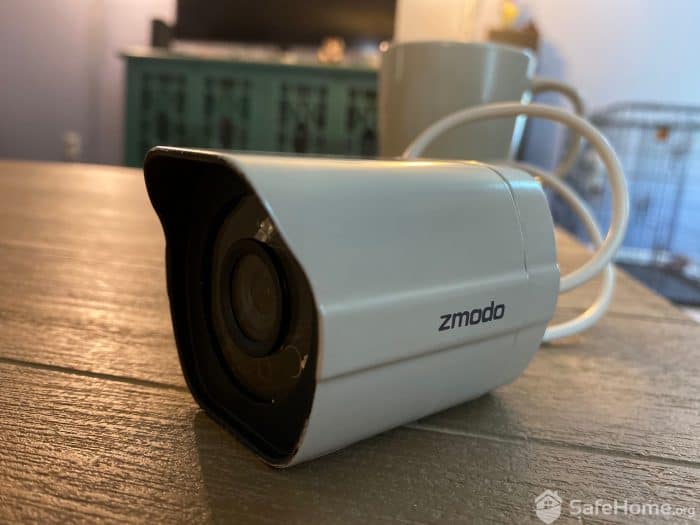
Zmodo 1080p
While it’s not knock-your-socks-off, dazzling 4K resolution, Zmodo’s image quality is still really impressive, especially considering it only costs $39.99. It actually reminded us of another standout inexpensive camera in our review lineup — Wyze. Their cameras offer great picture quality that won’t drain your account. Great news for folks who need multiple cameras to secure their properties.
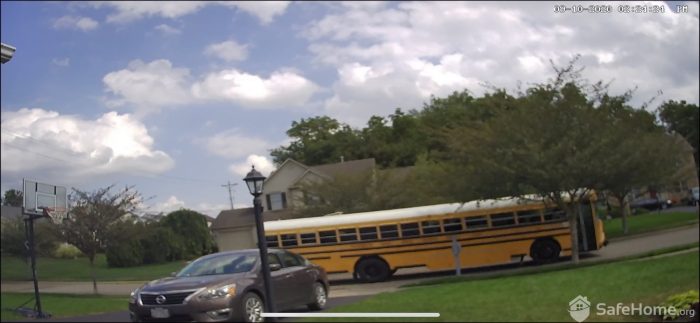
Zmodo 1080p image quality
We saw really good footage from our hands-on Wyze review, so we knew it’s possible to get clear videos from an affordable camera. Unfortunately, we were a bit disappointed by the Zmodo 1080p Wi-Fi Cam. Notice anything weird in the snapshot above?
While the image was clear and the color contrast was good, the objects seemed a bit stretched out. The schoolbus, for example, looked longer in the video than it actually was. This was most likely a result of the camera’s limited 90-degree field of view. For context, 90 degrees is equivalent to a quarter of a whole pie. You want your outdoor cameras to capture at least 130 degrees to cover good ground.
Now, a camera with a 90-degree viewing angle is best viewed in a square aspect ratio, but when we viewed Zmodo through the app, it stretched the image to fit the screen. That resulted in distortion. This is a minor thing, to be honest, but just something to keep in mind.
Another thing to keep in mind is that the camera doesn’t record audio. It doesn’t have a mic and speakers on it, so you can’t use it as a two-way intercom either. This was a bit disappointing to find out, as two-way audio makes a great crime deterrent.
Now let’s turn our attention to the second camera in our test, the Sight 180 C.
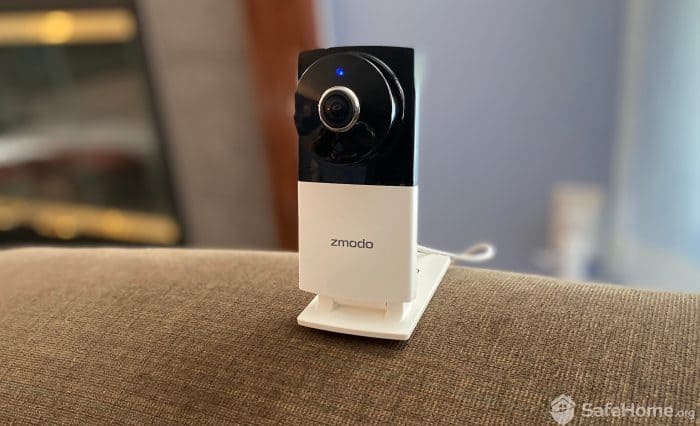
Zmodo indoor camera
Zmodo’s lightweight, low-maintenance Sight 180C doesn’t have too many knock-your-socks-off features, but it does have a 180-degree viewing angle, which is about 50 degrees wider than its most in-demand competitors. Ring’s Stick Up Camera, for instance, has a viewing angle of 130 degrees, but how much you really need a wide-angle lens ultimately depends on where and how you’re using the camera.
In our pie context, 180 degrees is equivalent to half the pie, so that’s wall-to-wall coverage for this Zmodo camera. Because of this, we referred to the Zmodo Sight 180 C as our “panoramic” camera. During our tests, we really noticed how much more this camera was able to pick up than similarly-priced counterparts. This was especially helpful for keeping an eye on our troublemaking puppy that likes to run amok while we were out running errands.
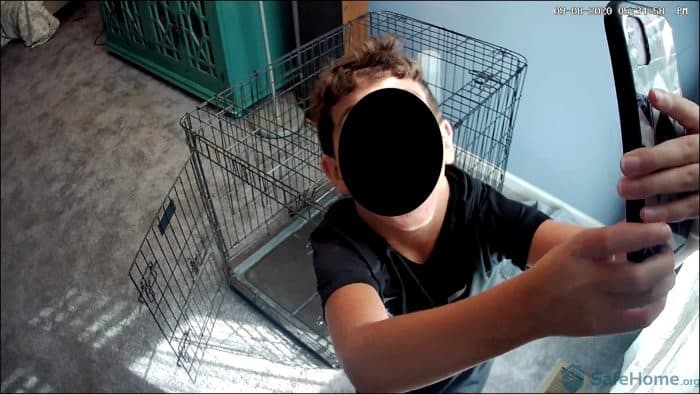
Zmodo Sight 180 C video quality
And, with all that coverage, it meant that we didn’t have to buy extra cameras to pick up what this one missed.
So if coverage is what you’re after, we think this is a great pick.
But like so many cameras we review, this one doesn’t come without some downsides.
First off, there’s no siren. Can you live with that? For indoors, we could. So this became a great, low-budget way for us to keep all the little ankle-biters in our home in check. We think we like it this way! However, it’s nice to have a siren on outdoor cameras, as it serves as an active crime deterrent. That’s one minor gripe we had about the Sight 180 C.
Pro Tip: If you are looking for active deterrent features in a security camera, Canary’s trio of cameras with a built-in emergency siren and call button might be a better choice. We took them for a spin in our Canary Security hands-on review, if you’re interested.
All things considered, both of our Zmodo cameras delivered decent video quality. But can we say the same with their nighttime performance? The answer is not a simple yes or no.
On one hand, the 1080p Wi-Fi Cam delivered excellent night vision range. Zmodo advertises a 65-foot infrared night vision range for this camera, and in the image below, you can see that it’s pretty long-range. But like any other camera, there’s a catch; any light in this camera’s field of view produced a strong halo effect that rendered any objects at or around it virtually invisible. We think the infrared sensor was just a tad too powerful.
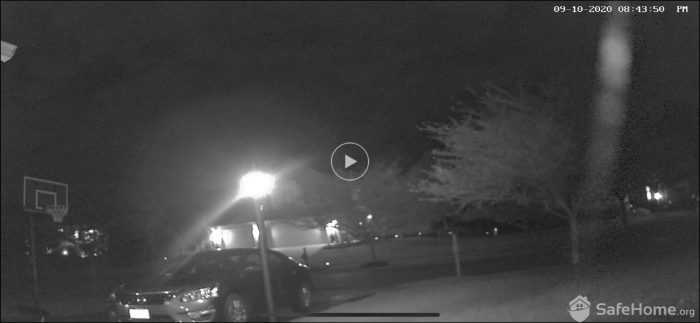
Zmodo outdoor night vision
On the other hand, the Sight 180 C’s night vision was comparatively weaker, but it worked quite well for our indoor setup. We’d say its night vision range is somewhere around 15 feet, which is plenty for an indoor camera. It wasn’t anything special, but what’s important is that it works.
And guess what? All of those things are pretty standard in cameras of this price point when it comes to night vision, so we were neither surprised nor disappointed.
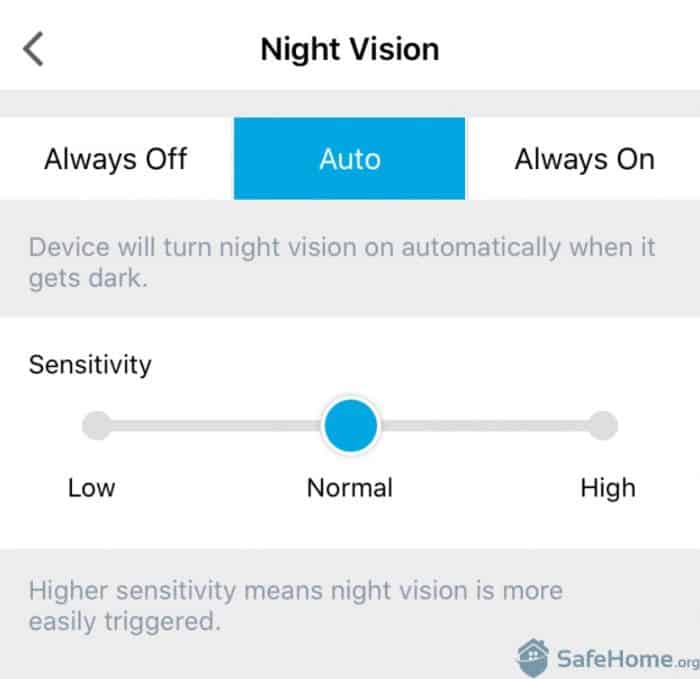
Zmodo app night vision sensitivity
Within the app, there are plenty of bright spots, too, like Night Vision Sensitivity, which helps us fine-tune alerts based on the sensitivity of the motion.
But it doesn’t end there. Our Zmodo camera also distinguishes between objects. In addition to straight-up motion, our camera was able to tell us if said motion was a person, animal, or vehicle.
They call fancy little features like this “intelligent alerts.” And we intelligent, safety-minded people really like that!
Look, she hasn’t learned to cook us dinner or clean our bathroom yet. But Amazon’s virtual assistant, Alexa3, can still learn a great deal about the devices in your home and allow you to use those devices hands-free. We wanted to check this out for ourselves, so we put it to work with our Zmodo cams.
Here’s our takeaway. Using Alexa to control our Zmodo cameras is not as simple as using Alexa to control, say, a Ring Doorbell.
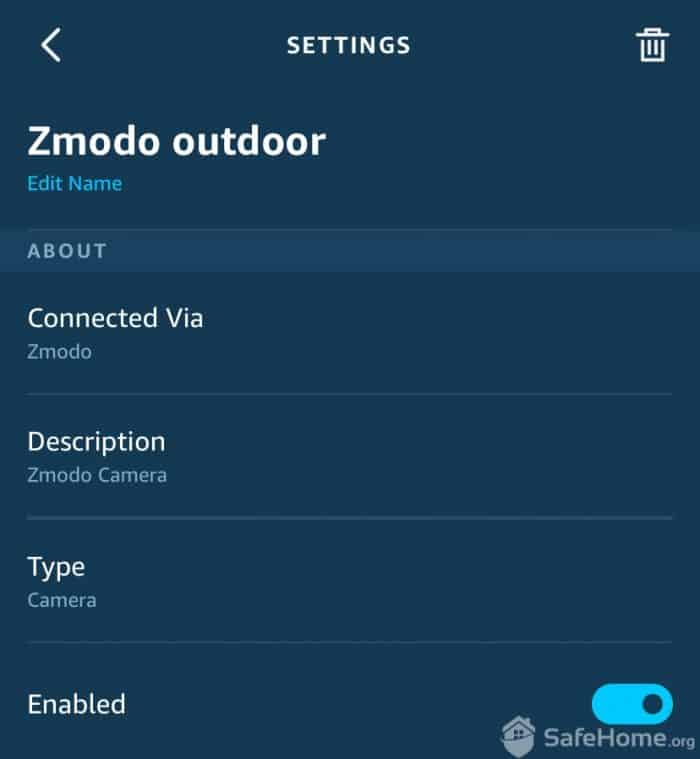
Zmodo Alexa app connection
That’s because Amazon owns Ring4, and Ring’s skill is embedded in our Amazon Echo Show.
Zmodo, clearly, is not owned by Amazon. So we had to do a little more legwork to get Alexa to recognize our third-party Zmodo cameras.
To do this, we went into our Amazon Alexa app in our phones and searched for Zmodo under Skills.
Then, we had to enter our Zmodo login and password.
And there it was! Not too difficult, but a little more time-consuming than Ring’s smart home experience.
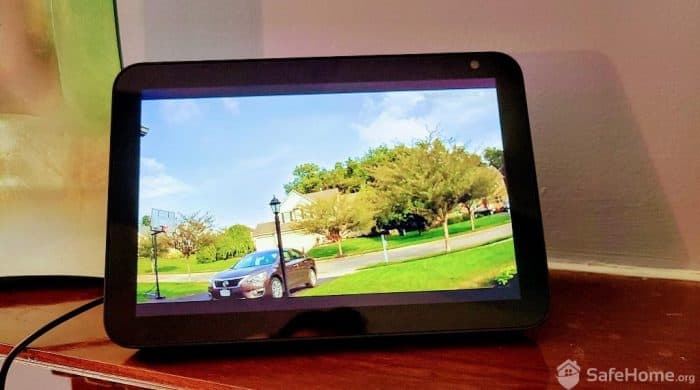
Zmodo Alexa display
The cool thing was, we could just leave this display up for as long as we wanted. So any time we heard something that didn’t sound right, or we knew we’d be getting a delivery, we didn’t have to stop whatever else we were doing to check on it. This team of multitaskers was quite grateful!
If video quality is a priority for you – and most likely it is – we think you’ll be pleased with Zmodo cameras. And, with that low price tag, it’s easy to justify buying multiple Zmodo cameras at once. If that’s what you’re after, we think you’ll appreciate Zmodo’s 2-, 3-, or 4-pack kits. It surely makes the whole buying experience easier!
Pro Tip: Zmodo seems to think a security camera is a great Mother’s Day gift. So much so, they’re offering 20 percent off all camera models for a limited time. We’re not sure a Zmodo Mini Pro is the best present for ole mom, but we’re not going to turn our nose up at those savings!
Here’s a full breakdown of Zmodo’s products and prices:
| Zmodo Camera | Camera Type | Key Features | Price |
|---|---|---|---|
| Zmodo Mini Pro | Indoor Battery | 130-Degree Vision, Smart Motion Alerts, 1080p Resolution | $39.99 |
| Zmodo Indoor/Outdoor WiFi Cam | Indoor/Outdoor | 65-Foot Night Vision, Smart Motion Alerts, Optional Cloud Recording | $39.99 |
| Torch 360 | Torch Light Cam | 360-Degree Views, Color-Change Functionality, Screw-In Power | $80.99 |
| Zmodo Pivot | Rotating Cam | Optional Cloud Recording, 1080p Resolution, 350-Degree Views | $59.99 |

Zmodo cloud plans
As we’ve been seeing more and more nowadays, subscription plans are becoming the way we’re all doing home security.
Zmodo’s menu of subscription plans is pretty standard for the industry: one basic plan for no charge, and a few upgrades that add a little pizzazz to our technology. For our purposes, we chose the premium plan, which gives us 7 days of free recording, among other features.
It’s worth noting, though, that monthly storage costs with Zmodo skew a bit higher than average for the industry. It’s dollars and cents, we know, but monthly costs can add up. Zmodo’s costs aren’t extravagant, as long as you can live with paying $5 per month to store 7 days of footage. For what it’s worth, that’s $2 more per month than you’d pay for a Ring premium cloud subscription. Just something to consider.
Here’s a look at Zmodo’s subscription options:
| Zmodo Cloud Plan | Basic | 7-Day Plan | 30-Day Plan |
|---|---|---|---|
| Video History Lookback | 12 hours | 7 days continuous cloud recording | 30 days continuous cloud recording |
| Alert Clip Storage | No | 7 days | 30 days |
| Custom Motion Zones | No | Yes | Yes |
| Video Editor & Time Lapse Clips | No | Yes | Yes |
| Monthly Price | Free | $4.99 | $9.99 |
| Yearly Price | Free | $49.90 | $99.90 |
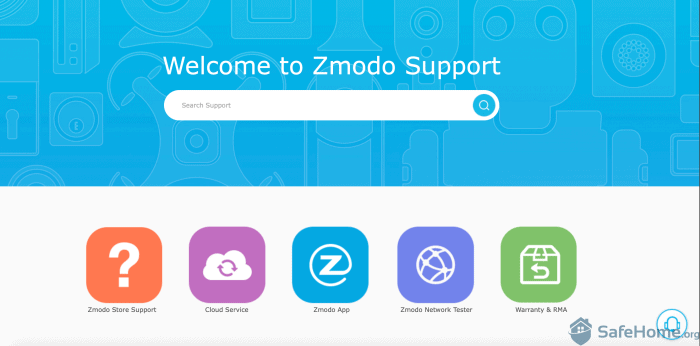
Zmodo support
We found Zmodo’s customer service experience to be useful, yet inconsistent. They’ve got plenty of help for people having trouble with installation and troubleshooting for lots of different topics. But in the event that you can’t find answers to your questions through the support page, we were happy to find a customer service phone number that led us pretty quickly to an agent, who answered our questions thoroughly.
We’ve also heard from people whose customer service experience was less than stellar; some have complained that the agent they called wasn’t knowledgeable enough about cameras but could write a novella about Zmodo’s state-of-the-art Wi-Fi extender.
Not the ideal outcome when you call an electronics company, so we understand the disconnect. For us, however, the experience was hassle-free.
As we continued to test and explore our Zmodo Sight 180 C and 1080p security cameras, we came across something that we couldn’t quite categorize, or compare to anything else.
Within the app’s Cloud settings, there’s a page that looks like this:
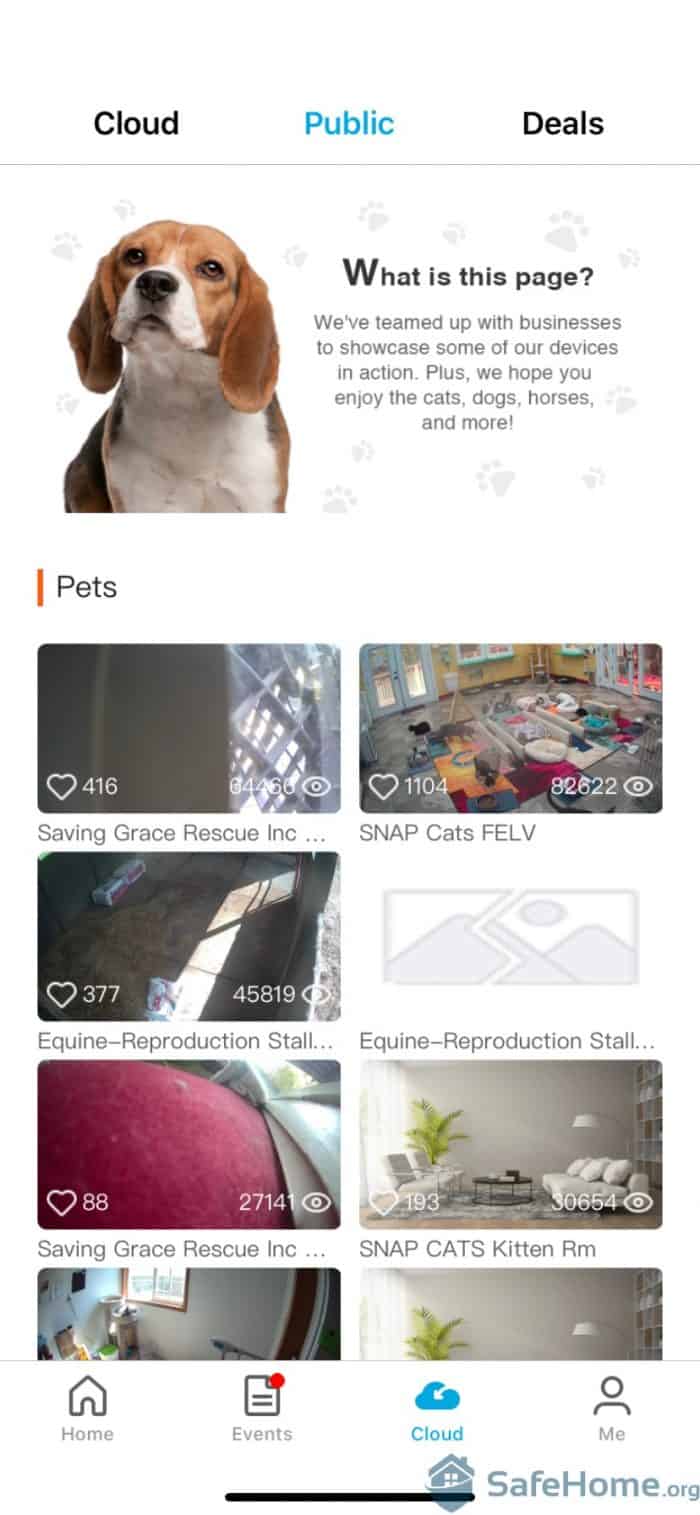
Zmodo cloud
At first glance, it looks like just another camera dashboard.
But, take another sniff, and you’ll see that this page is actually a bunch of displays of animal rescues around the U.S. that are streaming their live camera feeds on Zmodo’s app, for some serious cuteness.
Even better: We learned that some of the pets we can see through these live feeds are available for adoption5. Other apps do this, but this is the first one we’ve seen in a security camera app. We love it!
Except we don’t entirely understand why this page just isn’t called “Pets” or “Devices in Action” or something similar, instead of “What is this page?” Can’t they just tell us what the page is?
But again, a minor gripe. After giving these cameras a good three-day run, we can say without hesitation that our Zmodo cameras deliver almost exactly what they promised, right up to that top-notch, crystal-clear video. So if you’re on the market for an affordable security camera that doesn’t skimp on features, we think Zmodo is definitely worth a consideration.
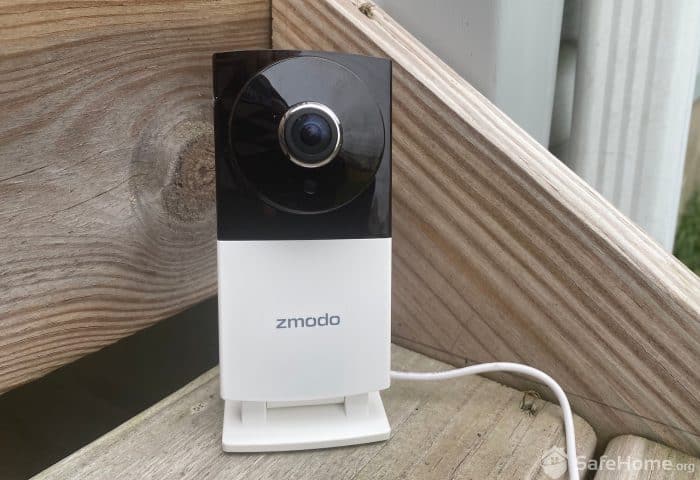
Zmodo camera pluged in
Yes. By linking your Zmodo account with Alexa, you can incorporate your cameras into any Amazon smart home ecosystem. If you’ve got an Echo Show, this is a great way to get instant insight into any activity in or around your property, or just pull up your live feed to check out the scene.
Yes. Zmodo’s $5-per-month cloud plan is an easy, inexpensive add-on and gives you a ton of space to store your videos. But it’s not required to use Zmodo cameras every day; you can also opt for a basic (free) plan, which automatically stores your last 12 hours of video history.
Mediocre at best. We didn’t get nearly the kind of clarity and detail that we got with cameras like Arlo and Ring, so it was hard to decipher dark-colored objects. This was especially difficult in high-activity areas; when we were alerted to motion through our phone, we couldn’t tell what was actually going on by looking at the clip. So if night vision is a priority for you, Zmodo might be a disappointing experience.
Low-cost technology usually comes with an unspoken warning: “You get what you pay for.” In Zmodo’s case, we didn’t find any huge flaws using their cameras in our home to monitor activity like wildlife sightings, porch piracy, and speeding cars. Everything did what it was supposed to do in our Zmodo cams. But for more advanced technology like facial recognition and built-in emergency response, you’ll have to pay more for a higher-end brand.
Since their camera features are pretty basic, you can’t really call Zmodo an artificial intelligence-powered camera brand. But they do have intelligent alerts to distinguish between people, animals, and vehicles when motion is detected.
Tong, S. Marketplace.org. Minnesota Public Radio. (2019, June 27). Shenzhen: birthplace to Huawei — plus several other Chinese tech behemoths. https://www.marketplace.org/2019/06/27/shenzhen-birthplace-huawei-chinese-tech-giants/
Lyne, M. Search Engine Land. (2009, Oct. 15). What is a QR Code, And Why Do You Need One? https://searchengineland.com/what-is-a-qr-code-and-why-do-you-need-one-27588
Rawes, E. and Wetzel, K. Digital Trends. (2020, Aug. 7). What is Alexa, Where Does She Come From, And How Does She Work? https://www.digitaltrends.com/home/what-is-amazons-alexa-and-what-can-it-do/
Schleifer, T. and Del Rey, J. Vox. (2018, Feb. 27). Amazon is making its second-biggest acquisition ever — the doorbell company Ring. https://www.vox.com/2018/2/27/17059768/amazon-ring-acquisition-doorbell
The Humane Society of the United States. (2020) Adopting from an animal shelter or rescue group. https://www.humanesociety.org/resources/adopting-animal-shelter-or-rescue-group